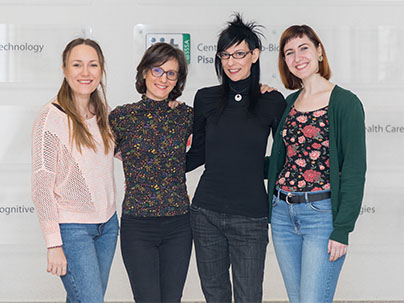A team of women for the European project funded with 8 million euro for 5 years
Gabriella Panuccio, Gemma Palazzolo, Natalia Ewa Gostynska and Fiamma Romagnoli are the four women researchers of the newly created Enhanced Regenerative Medicine Lab group at IIT, involved in the European project HERMES, funded as part of the European Union’s ambitious FET-Future and Emerging Technologies projects. Gabriella Panuccio, with a background in medicine and a PhD in biophysics, is the coordinator of the group and the international project. “When I heard that the project had been selected for funding, it was a moment of great excitement, I was seeing a dream I had been pursuing for so many years come true,” comments Panuccio, who returned to Italy in 2016, after a period of work in Canada and Belgium, thanks to another European grant, a Marie Skłodowska-Curie actions young researchers grant.
“HERMES represents a turning point in my life as a researcher, as well as a very important opportunity for growth,” emphasises Panuccio, who now finds herself coordinating for the next five years a project financed with over 8 million euros, and involving 12 international partners, including in Italy the University of Modena and Reggio Emilia, the University of Verona, the Milan Polytechnic and the Eurokleis consulting company.
At the heart of the HERMES project is the study of a new strategy to treat epilepsy, aiming at regenerating damaged brain tissue and training neurons to function properly through the combined use of biological and artificial components.
Epilepsy is a disease characterised by progressive damage to certain areas of the brain, resulting in abnormal brain functioning. To date, epilepsy affects 50 million people worldwide, of which 8 million in Europe and 500 thousand in Italy. In HERMES, researchers will study temporal lobe epilepsy, the most widespread and the one most often found to be resistant to current drug therapies. The disorder affects areas of the brain involved in learning, memory and emotional control, such as the hippocampus.
‘Our project is very ambitious, but if we succeed, it will open up new perspectives for research into brain disorders, going beyond the limits of more traditional treatments,’ says Panuccio, ‘Our aim is to show that it is possible to establish a dialogue between biological and artificial systems, so as to obtain biohybrid technologies for treating the diseased brain. We want to go beyond the concept of regenerative medicine as a purely biological method: we need to use new technologies to help tissue integrate properly into the brain’.
HERMES will aim precisely at reconstructing the damaged part of the hippocampus. The researchers will create hippocampal tissue in the laboratory on the one hand, and a neuromorphic neuroprosthesis, i.e. an electronic device that mimics the behaviour of neurons, on the other. The two components, one biological and the other electronic, will be implanted in the brain of an animal model in the damaged area. The neuroprosthesis, equipped with artificial intelligence, will guide the implanted tissue towards proper integration with the other brain areas, avoiding the alterations typical of epilepsy. The device will therefore act as a ‘trainer’ for the tissue recreated in the laboratory, so that it can be discarded once complete regeneration and normal function of the brain area has been established. The new paradigm introduced by HERMES is called enhanced regenerative medicine.
The construction of an interface between a biological and an artificial system opens up ethical and philosophical reflections, which will be addressed during the project thanks to the involvement of expert partners in the field, as well as during public events throughout Europe.
In particular, Italian institutes will contribute to the project in a synergic way: IIT with tissue engineering and the analysis of electrical signals generated by neurons in vitro; the University of Verona with the study of neurogenesis and stem cells; the University of Modena and Reggio Emilia with the analysis of electrical signals generated by the brain in vivo; the Politecnico di Milano with the engineering of neuromorphic circuits. Eurokleis will follow the communication and management aspects of the innovation processes triggered by the project.
In the future, HERMES technologies may have a long-term impact on people’s lives, their health and well-being.
The HERMES consortium consists of: IIT-Italian Institute of Technology, University of Modena and Reggio Emilia, University of Verona, Milan Polytechnic, Eurokleis S.r.l., Agencia Estatal Consejo Superior de Investigaciones Cientificas (Spain), Aarhus Universitet (Denmark), University of Glasgow (United Kingdom), Tampere University of Technology (Finland), Fundacion Instituto de Estudios de Ciencias de la Salud de Castilla y Leon and Universidad de Salamanca (Spain), Radboud Universiteit (The Netherlands), Den Institute (Belgium).





